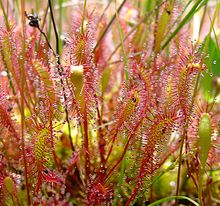Drosera anglica
| Drosera anglica | |
|---|---|

| |
| Scientific classification | |
| Kingdom: | Plantae |
| Clade: | Tracheophytes |
| Clade: | Angiosperms |
| Clade: | Eudicots |
| Order: | Caryophyllales |
| Family: | Droseraceae |
| Genus: | Drosera |
| Subgenus: | Drosera subg. Drosera |
| Section: | Drosera sect. Drosera |
| Species: | D. anglica
|
| Binomial name | |
| Drosera anglica Huds. | |
| Synonyms[2] | |
|
List
| |
Drosera anglica, commonly known as the English sundew
Morphology

Drosera anglica is a
Drosera anglica flowers in the summer, sending up peduncles 6–18 centimetres (2.4–7.1 in). long bearing several white flowers which open individually. Like other sundews, the flowers have five sepals, petals, and stamens with three styles. The petals for this species are 8–12 mm (¼ to ½") long, and the flowers have branched 2-lobed styles.[6] The odorless, nectar-less flowers do not rely on insect pollinators for pollination, rather setting seed well through self-pollination (autogamy).[7] The black roundish spindle-shaped seeds,[8] are 1 to 1+1⁄2 mm long. The fruits are a dehiscent three-valved capsule.
Carnivory

Like all sundews, D. anglica uses stalked
The plant's initial response to contact with prey consists of
Taxonomy
Drosera anglica was given its first scientific description and named by the botanist William Hudson in 1778. Constantine Samuel Rafinesque proposed moving it and other species to a new genus named Adenopa in 1837, but this was not accepted.[2]
Habitat

Drosera anglica grows in open, non-forested habitat with wet, often calcium-rich soils. These include
Distribution

Drosera anglica is one of the most widely distributed
Special origins
All North American Drosera species except for D. anglica have a
All North American Drosera species produce sterile hybrids. The natural hybrid D. rotundifolia × D. linearis (conventionally but incorrectly referred to as Drosera ×anglica), is also sterile but is morphologically similar to the modern D. anglica.[5] Errors in meiosis during ovule and pollen production, however, can result in a chromosome doubling which can allow for viable seed to be produced. The resulting plants, known as amphiploids, would be fertile. Woods noted that this appeared to be an ongoing process with D. anglica speciating from D. rotundifolia × D. linearis through amphidiploidy in multiple locations.[11] The question remains as to why D. anglica is so widespread, whereas the range of D. linearis is limited to the Great Lakes region of North America. The greater adaptability of D. anglica to varied habitat conditions could be a major factor.[5]
Botanical history
Drosera anglica was first described by William Hudson in 1778. It has frequently been confused with the other circumpolar long-leaf Drosera, D. intermedia. This confusion was fueled by the resurfacing of an older name, D. longifolia (described by Carl Linnaeus in 1753), which was regarded as being too ambiguous in description and had been applied to specimens of both D. anglica and D. intermedia. Herbarium specimens were also a mix of the two species. These points led Martin Cheek to propose D. longifolia for rejection as a species name in 1998.[12] The proposal was accepted and the taxon listed as rejected in 1999.[13]
Hybrids
Several naturally occurring
| D. anglica × capillaris | = D. × anpil |
| D. anglica × filiformis | = D. × anfil |
| D. anglica × linearis | |
| D. anglica × intermedia | = D. × anterm |
| D. anglica × spatulata | = D. × nagamoto |
| D. linearis × anglica | = D. × linglica |
| D. rotundifolia × anglica | = D. × obovata |
These are all sterile. In addition, several man-made hybrids have been made.
Gallery
-
A dense carpet of flowering D. anglica on a quaking bog
-
An atypical D. anglica flower with 6 petals
-
Several damselflies ensnared by some English sundews
-
D. anglica growing in a mountain bog, British Columbia, Canada
References
- ^ a b NatureServe (2024). "Drosera anglica". Arlington, Virginia. Archived from the original on 9 April 2023. Retrieved 6 March 2024.
- ^ a b c "Drosera anglica Huds". Plants of the World Online. Royal Botanic Gardens, Kew. Retrieved 6 March 2024.
- ^ USDA, NRCS (n.d.). "Drosera anglica". The PLANTS Database (plants.usda.gov). Greensboro, North Carolina: National Plant Data Team. Retrieved 18 January 2016.
- ^ BSBI List 2007 (xls). Botanical Society of Britain and Ireland. Archived from the original (xls) on 2015-06-26. Retrieved 2014-10-17.
- ^ S2CID 248090242.
- ^ a b Regents of the University of California (1993). The Jepson Manual: Higher Plants of California. Berkeley, California: University of California Press.
- .
- ^ ISBN 978-0-8166-1689-3.
- ^ a b Penskar, M.R.; Higman, P.J. (1999). Special Plant Abstract for Drosera anglica (English sundew) (PDF). Lansing, Michigan: Michigan Natural Resources Inventory. Archived from the original (PDF) on 2006-01-17. Retrieved 2006-04-22.
- ^ Averis, Benand Alison (1998). Vegetational Survey of Deer-Fenced Area South-West of Sandwood Loch, Sutherland, June 1998. Sutherland, UK: John Muir TrustSurvey Report.
- ^ a b c Wood, C.E. (1955). "Evidence for Hybrid Origin of Drosera anglica". Rhodora. 57: 105–130.
- JSTOR 1223604.
- JSTOR 1224449.
External links
- Jepson Manual Treatment
- Species account, photographs, and Wisconsin distribution from Wisconsin State Herbarium (UW-Madison)
- GRIN taxonomy page, including global distribution info
- Key to North American Drosera species
- Cultivation Information
- International Carnivorous Plant Society
- Insectivorous Plants (1875) by Charles Darwin
- Wolf, EC; Gage, E; Cooper, DC (2006). Drosera anglica Huds. (English sundew): A technical conservation assessment (PDF) (Report). USDA Forest Service, Rocky Mountain Region, Species Conservation Project.






